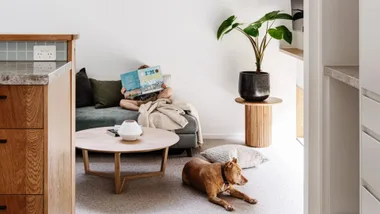The environmental impact of the fast fashion industry is well documented, but the growing fast furniture and décor industry is quietly becoming just as destructive. A new report, published by French organisations Zero Waste France, Les Amis de la Terre and Réseau National des Ressourceries et Recycleries, has called out the fast furniture industry for following the same problematic business model as fast fashion giants — one based on producing high volumes of cheap products.
According to Barb de Corti, CEO of ENJO, the report is the first of its kind to focus attention on the negative effects of the industry.
“Furniture, decorations, homewares, cleaning and organising products are bulky, take a lot of resources to manufacture, transport, sell and discard, and most of it is not being recycled properly,” Barb explains.
The report noted that the demand for these items was likely fuelled by the COVID-19 pandemic, with an additional study published in Les Échos finding furniture sales increased by 88% in France between 2017 and 2022. Unfortunately, the rise in furniture waste also increased, doubling between 2014 and 2022. While the report focused on the rise of fast décor in France, it’s very likely that Australia and other countries are experiencing the same issues.
But in a world of ever-changing micro trends, social media storefronts and designer dupes, how do we resist the temptation of these cheap, on-trend items? We spoke to Barb de Corti to find out.
What is fast décor?

Fast décor can encompass a wide range of items in the furniture and homewares industry.
“We’re talking homewares that are based [on] more high-end designer goods — from vases to cleaning products — that are aesthetically pleasing,” Barb explains. “So many of these ‘dupes’ are ripped off from smaller brands that can’t really compete with fast décor giants.”
These items can usually be identified by their low price and quality, with fast décor producers typically renewing their collections at a very fast pace.
“Big chains like Zara Home, Kmart, Shein and H&M are big sources of fast décor, and they often use big holidays to push more low-priced, low-quality, high volume products to consumers,” Barb says.
“Social media also plays a role in stimulating consumers to purchase more and the result is a mass of products being sent to landfill.”
The problem with fast décor
The biggest problem with fast décor is its impact on our environment.
“At a time when single-use items are being phased out and brands are trying to be more conscious about their impact on the environment, fast décor is a sneaky phenomenon that is derailing our efforts to clean up the planet,” Barb explains.
The best way to understand the problem with the rise of fast décor is to look at consequences of the fast fashion industry.
“We’re aware that fast fashion is a scourge on the planet,” says Barb. “Research on the fast fashion industry suggests that due to the overproduction and overconsumption of clothes, we would have enough garments to last us six generations. If we were to stop producing clothes today, we could theoretically reuse, repair and repurpose the multitudes of clothing that sit unworn in our closets to clothe every person on the planet.
“This gives us an idea of the vast scale of overconsumption that is flooding the planet. We don’t need fast décor to exacerbate this problem even more, especially since cheap furniture and décor is so much bulkier and harder to dispose of at the end of their (very short) life cycles.”
5 ways to avoid fast décor

Fast décor doesn’t only have a negative impact on the environment, but the design of our homes as well — no one wants to know that their new favourite cushion already sits on the couch of their next-door-neighbour, colleague or mother-in-law. Our homes typically develop more character and style when we are slower and more intentional about the items we bring into it.
“The only real way we can minimise fast décor’s impact on our budget and on the planet is by consuming less,” Barb says. “We need to think really hard about whether these fast décor items bring long-term joy and if they truly are of value to us. Just because it’s affordable doesn’t mean it’s worth buying.”
While completely cutting out fast furniture items might not be possible for everyone, we can all be a little more intentional with our purchases.
Barb’s best tips for avoiding fast décor
- Adopt a less is more mindset: Be intentional about what you bring home and embrace the old-fashioned principles of buying better quality items that will last.
- Cut down on single use items: From cleaning products such as wet wipes, chemicals and cheap plastic mops to seasonal décor, cutting down on single-use items will keep our homes clutter-free and easy to maintain.
- Embrace classic themes: Opt for timeless items that won’t go out of style with the coming and goings of trends.
- Fall out of love with buying new stuff: Instead of gifting or rewarding yourself with more stuff, find other ways to entertain and reward yourself — whether it’s with a delicious meal, a long walk or a massage.
- Reuse items: Recycle responsibly by checking council websites and offer usable items to others in no-buy groups before throwing it away in landfill. Instead of buying new, consider buying second-hand, or repairing and reusing existing items.
 Getty
Getty








